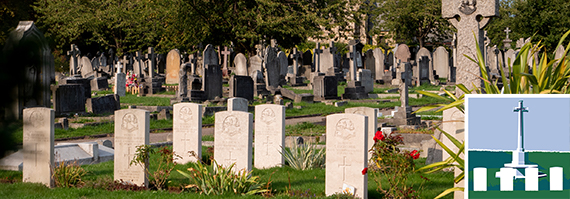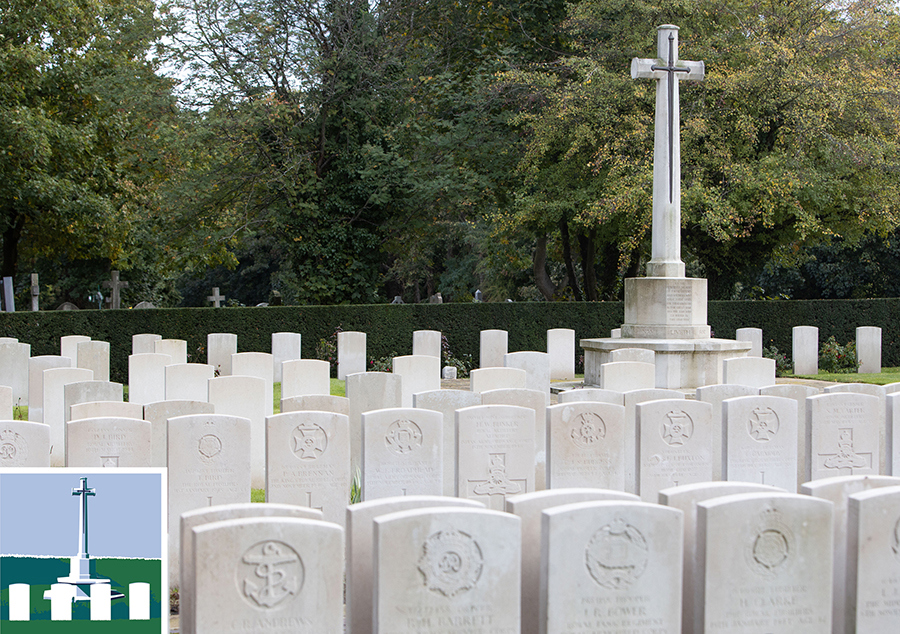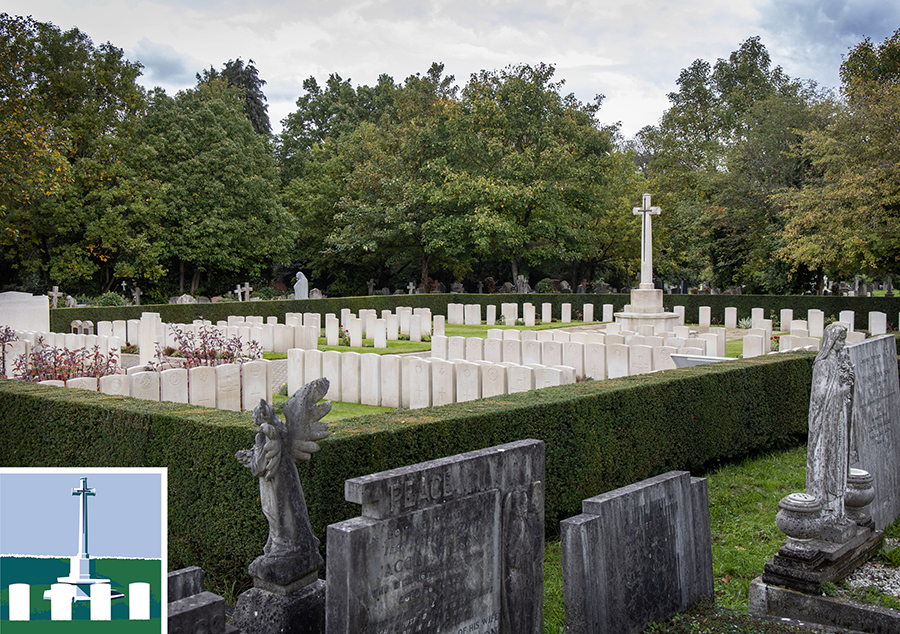St. Pancras Cemetery & Islington Cemetery and Crematorium
St. Pancras Cemetery & Islington Cemetery and Crematorium stand side by side in north London. Over a million people are buried here, including more than 1,120 service personnel of the World Wars.
![]()
The first thing to note about St. Pancras Cemetery & Islington Cemetery and Crematorium is that neither site is located in the Boroughs of Camden (which includes the former borough of St. Pancras) or Islington, instead they are located in Barnet, in north London. The second point to note is that although technically two separate war cemeteries, each belonging to their respective boroughs, to look at they form a single continuous site which stretches over 190 acres. Over 1,120 Commonwealth servicemen and women are commemorated at St. Pancras Cemetery (512) and Islington Cemetery and Crematorium (617).
Find out more about the history of this cemetery
Established in the 1854, St. Pancras Cemetery was the first municipally owned cemetery in London. Established a time when London’s population was rapidly expanding, clear land was sort on what was then the outskirts of the city, on Finchley Common in Barnet, north London. Further land was acquired in 1877, and the 190-acre site was divided between St. Pancras and the neighbouring brough of Islington, to form two cemeteries.
Over 1,120 Commonwealth servicemen and women are commemorated at St. Pancras Cemetery, the majority are British servicemen but there are also 10 Canadian, three Australian and one South African serviceman commemorated here. Amongst their number are eleven women of the Auxiliary Territorial Service, Women's Auxiliary Air Force, Women's Royal Air Force and Women's Royal Naval Service. There are also four Belgian and one French servicemen of the First World War.
In St Pancras Cemetery there are 308 First World War commemorations, including 1 unidentified sailor of the Royal Navy, and 208 from the Second World War. Over 100 graves from both wars form a war graves plot. The plot also contains a number of headstones removed from graves scattered elsewhere in the cemetery that could not be maintained. A further memorial bears the names of 27 casualties whose graves could not be marked individually, and six First World War casualties buried in adjacent Islington Cemetery who could not be commemorated there.
Islington Cemetery contains 344 First World War graves and 265 graves from the Second World War, all scattered throughout the cemetery. A screen wall in the western part of the cemetery bears the names of those whose graves could not be marked individually, together with the names of two casualties from the Second World War whose remains were cremated at Islington Crematorium.
A number of those buried in St. Pancras Cemetery & Islington Cemetery died in one of the many military and civilian hospitals in and around London during the two world wars, while others were buried there as they had a family connection to the area. They died of wounds received on the fighting fronts, sickness & disease as well as accidents. A few were killed by direct enemy action including during the V1 and V2 rocket attacks on Britain in 1944-45.
A total of 6,876 flying bombs and rockets hit the UK between June 1944 and March 1945. Nearly 9,000 people were killed, mostly in London, and over 24,000 injured. The highest casualty rate for a single incident was on 23 August 1944, when a flying bomb killed 211 people in East Barnet. On that same day a V1 also stuck Blaxland House, a block of red brick flats on the White City Estate in Hammersmith. 17 people from nine different families were killed and 26 others were seriously wounded. Three of those killed were 18-year-old Ellen Saunders and her parents, George and Ellen Rose Saunders.
George Saunders, who served with the Royal Navy, had returned on leave having been away at sea for nearly three years and his daughter Ellen, was serving with the Women's Royal Naval Service had been stationed at the Royal Naval Air Station Henstridge in Dorset, had been granted leave to visit her father. All three family members were buried together in St. Pancras Cemetery. Their graves could not be marked however, so as serving members of the armed forces George and Ellen are commemorated by the Commission by special memorial in the cemetery, while Ellen Rose, and the 14 other civilians killed at Blaxland House, are recorded in the Commission’s Civilian Roll of Honour, housed in Westminster Abbey.

Wren Ellen Saunders with thanks to Michelle
Visit St. Pancras Cemetery & Islington Cemetery and Crematorium
Access to this large site can be gained at multiple locations. The main entrance is from High Road A1000. The cemetery is run by Islington and Camden Cemetery Services and before visiting we recommend that you consult their website.

The sailors of the Merchant Navy sailed on hostile seas during the world war and this memorial in the heart of London commemorates more than 36,000 Merchant sailors who have no grave but the sea.
Tower Hill Memorial
Situated in the heart of East London, the City of London Cemetery and Crematorium is one of the largest municipal cemeteries in Europe. You will find more than 700 service personnel commemorated here.
City of London Cemetery and Crematorium
The final resting place of close to 600 servicemen and women of both world wars. Over half of those buried in the cemetery are now named on screen walls as their graves cannot be individually marked.
Wandsworth (Earlsfield) Cemetery
Nunhead (All Saints) is perhaps the least well known of London’s ‘magnificent seven’ Victorian cemeteries, home to nearly 700 Commonwealth war graves.
Nunhead (All Saints) Cemetery




